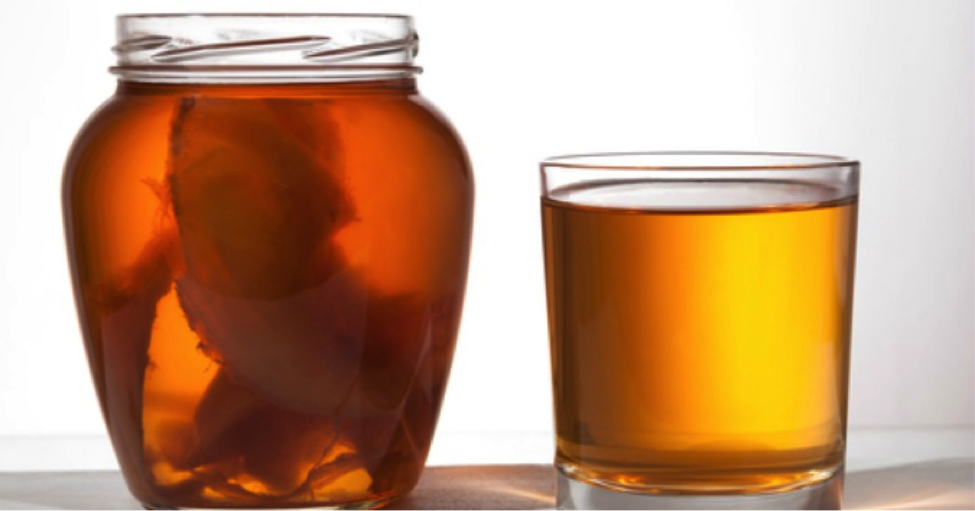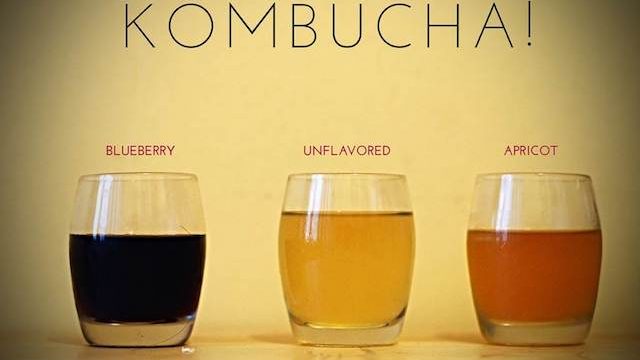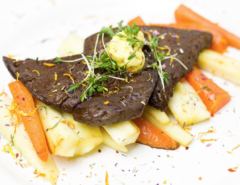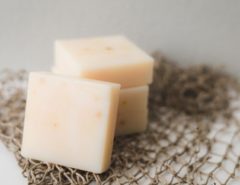By Bryan Quoc Le | 150 Food Science Questions Answered
Kombucha tea is a popular sour, effervescent drink that is made from the fermentation of sweetened tea by a symbiotic culture of bacteria and yeast, affectionately called a SCOBY [1]. The SCOBY is a tiny ecosystem of microorganisms consisting of a number of species, including Gluconacetobacter xylinus, Acetobacter aceti, Saccharomyces cerevisiae, and other buddies, bound together by a jelly-like microbial mat made of mostly cellulose [2]. When placed in sweetened tea, these microbes go to town eating the available sugars and converting them into ethanol, acetic acid, gluconic acid, carbon dioxide and a little bit of cellulose. The SCOBY not only helps create a protective environment within the kombucha that reduces spoilage by outcompeting other microbes, it also creates flavor.

Yum. http://www.oursmallhours.com/how-to-make-kombucha-tea/
The best tea and natural substrate for the SCOBY is black tea, although both green and white teas are also commonly used. The biggest difference between black, white, and green tea kombuchas is the concentration and types of naturally occurring compounds in the tea known as polyphenols. Polyphenols largely contribute to the characteristic astringency, bitterness, and aftertaste experienced in teas. They have also been heavily investigated for their potential bioactive properties and benefits to human health [3]. All teas start from the leaves of the Camellia sinensis shrub and it’s how they’re processed that differentiates each tea variety and gives them their characteristic flavors and colors. White tea is made by lightly drying the tea leaves in the sun and air to minimize the oxidation of polyphenols. Green tea is only somewhat more oxidized through a combined steaming and drying process, leaving the majority of the polyphenols still in their native form. Black tea, on the other hand, undergoes an intensive processing method in which the leaves are warmed for a period of time to allow a native enzyme, called polyphenol oxidase, to fully oxidize the polyphenols found in the leaves [4]. It’s this same enzyme that makes black tea so delicious that also turns your beautiful sliced apples into a brown pit of despair.

The sad work of polyphenol oxidase. http://www.foodpyramid.com/how-to-keep-apples-from-turning-brown/
While white and green teas contain mostly polyphenols with fancy names like catechins, quercetin, kaempferol, and myricetin, black tea contains the oxidized polyphenol families of theaflavins, theaflavinic acid, thearubigins, and theasinensis. The oxidation process also produces proanthocyanidin polymers, which really gives black tea that strong characteristic astringency [5]. Other components of teas include theobromine, theanine, and small amounts of vitamins and minerals. Green tea kombuchas have been said to have a grassy or earthy flavor, giving a lighter, fresher taste. Black tea kombuchas, on the other hand, have stronger flavors owing to the larger amounts of oxidized polyphenol, and white tea kombuchas are very mild in flavor due to the very low levels of oxidized polyphenols [6].
The process of kombucha fermentation results in a beverage with less caffeine than regular black or green tea because the SCOBY microbes get busy using up caffeine as a nitrogen source, which leads to an increase output of the cellulosic mat [7]. With more caffeine per cup, black tea encourages the production of cellulose, leaving less sugar to be transformed into acetic acid and other organic acids compared to green tea-based kombucha. As a result of this, black tea tends to yield a less sour kombucha over green tea kombuchas. Much of the flavor of a kombucha tea is dominated by acetic acid, which gives that sour vinegar-like taste, with some variations depending on the type of tea used and the manner in which the kombucha is made. Since sugar is required to promote the fermentation process, most kombucha teas have a hint of sweetness following their sour notes. Also, the longer the SCOBY sits in the tea, the tarter and less sweet the tea will become as more sugar is transformed into acetic acid. Commercial kombucha teas typically have added flavors, such as ginger, blueberry, lemon, lime, and mixed fruits, to help make that vinegar flavor more palatable.

https://giphy.com/search/kombucha
Surprisingly, there are numerous alternative uses for kombucha beyond being a beverage. Over-fermented kombucha tea can be used in place of traditional vinegars, such as in salad dressing, pickling, and marinades. Some creative folks have found ways to eat the SCOBY, as a jerky, fruit leather, candy, or as a meat alternative. Kombucha has even been looked into as a possible regenerative source of probiotics and prebiotics to improve the immune system of astronauts on long-term space missions [8].
Of course, we cannot forget about the fact that there’s a little niche use for SCOBY cellulose as a sustainable fabric for a certain line of fashion, Biocouture.

That’s right, kombucha clothing. It’s a thing. http://fashioningcircuits.com/?p=2127
At the end of the day, whether you decide to drink your kombucha tea or use it to make stylish faux leather, we can all agree that the biochemical processes that goes into transforming a humble cup of tea into a rich culture of microorganisms and tasty sour flavors is nothing short of amazing. Each brew is unique in flavor, color, acidity, sweetness, and mouthfeel, depending on many different factors – temperature, sugar concentration, tea type, time, pH, and so much more. Not to mention, the SCOBY is continuously growing and adapting, slowly changing its genetic makeup to match the conditions it’s living in.
So here’s to kombucha tea, the living, ever-changing drink!
References
- Greenwalt, C.J.; Steinkraus, K.H.; Ledford, R.A. Kombucha, the fermented tea: microbiology, composition, and claimed health effects. Journal of Food Protection, 63(7): 976-981.
- Teoh, A.L.; Heard, G.; Cox, J. (2004). Yeast ecology of Kombucha fermentation. International Journal of Food Microbiology, 95(2): 119-126.
- Manach, C.; Scalbert, A.; Morand, C.; Rémésy, C.; Jiménez, L. (2004). Polyphenols: food sources and bioavailability. American Journal of Clinical Nutrition, 79(5): 727-747.
- Subramanian, N.; Venkatesh, P.; Ganguli, S.; Sinkar, V.P. (1999). Role of polyphenol oxidase and peroxidase in the generation of black tea theaflavins. Journal of Agricultural and Food Chemistry, 47(7): 2571-2578.
- Dufresne, C.; Farnworth, E. (2000). Tea, Kombucha, and health: a review. Food Research International, 33(6): 409-421.
- Green Tea vs Black Tea for Kombucha. Kombucha Home.

Bryan Quoc Le | 150 Food Science Questions Answered
IFTSA VP of Digital and Social Media (2019-2020)
Bryan is the author of 150 Food Science Questions Answered (Rockridge Press, 2020) and a Ph.D. candidate in Food Science at University of Wisconsin-Madison studying the health effects of garlic and onion flavors. He received his B.S. and M.S. in Chemistry at the University of California, Irvine. In another life, he walked 2,000 miles from California to Louisiana in six months, and learned that eating tuna and peanut butter every day was not meant for the average human body. After he met his wife, he learned that there was more to good food than canned goods and smoothies. While not juicing onions and pressing garlic, Bryan likes to run half-marathons, discover interesting cuisines with his wife, and help entrepreneurs develop great food products.






Leave a Reply